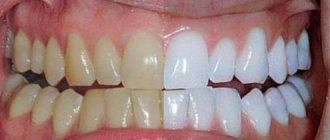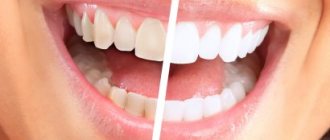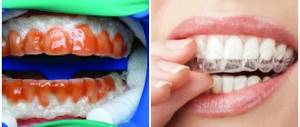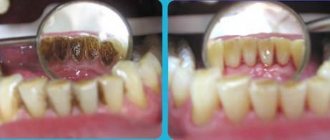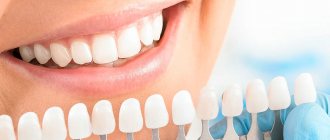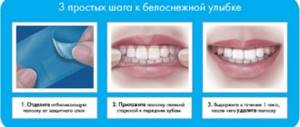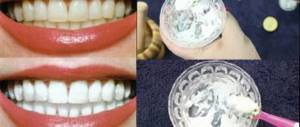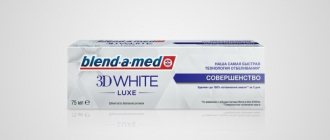The essence of the method
The peculiarity of restorative whitening is that the method allows you to give your teeth not only the desired shade, but also correct minor flaws (chips, cracks, stains, gaps between teeth). Please note that restoration methods do not affect the original color of the patient’s enamel and do not contribute to the destruction of unsightly pigment, as classical methods do, namely, they hide the defect. In this case, the patient has the opportunity to choose the color and degree of whiteness of the enamel, that is, he receives a predictable result, which is usually difficult to achieve with traditional lightening methods.
It is impossible to whiten chips and cracks in enamel using the usual method.
The purpose of restorative whitening is to improve the appearance and even correct the shape of row elements located in the smile area. The procedure is not carried out in the chewing area, since the materials used for it are not designed to withstand heavy loads.
The essence of the procedure for restorative teeth whitening comes down to the fact that the doctor applies artificial material to the frontal (front) surface of hard tissues or glues thin but very durable overlays that exactly imitate the color and shine of natural enamel. If the patient wishes, the specialist will always be able to remove, refresh or adjust the restorations, or select a new color.
Negative consequences of bleaching artificial materials
When carrying out artistic restorations and prosthetics, doctors try to choose a color that matches as closely as possible the natural shade of the patient’s enamel. However, over time, both the natural enamel and the restorations themselves can darken. That's why many people think about whitening. But at the same time, not everyone is ready to take the word of the dentist that this is impossible. Some people try to do lightening at home, for example, using highly abrasive bleaching pastes, soda, hydrogen peroxide, and store-bought gels. What negative consequences can this lead to?
- neighboring teeth will become lighter, but the restoration will not change its color and will look even darker against the general background,
- Cracks, scratches and chips will appear on artificial materials: bleaching compounds aggressively affect not only the enamel, but also the restorations, they can damage them and significantly reduce their service life. Remember that the resulting cracks are secluded places for the accumulation of bacteria that provoke dental diseases.
A number of researchers1 have found that bleaching agents can destroy the strength and hardness of artificial materials and contribute to the formation of roughness on them. Moreover, products made from some materials, for example, methyl methacrylates, can become orange after exposure to peroxide and urea, and amalgam fillings can become toxic. Designs made of gold and porcelain are subject to the least negative impact.
Indications for the procedure
- inability to achieve the desired effect using classical methods of enamel lightening: for example, if the patient has stains caused by severe forms of fluorosis and hypoplasia, yellow “tetracycline” teeth,
- sensitivity and increased abrasion of hard tissues: restorative bleaching performs not only an aesthetic, but also a protective function,
- in addition to the unsightly shade, the patient needs to eliminate a number of other defects: restore the anatomical shape of a chipped tooth, hide interdental gaps and cracks, hide old fillings, correct the position and shape of a crooked unit,
- age up to 18 years: some methods of restorative bleaching (for example, using composite materials) are suitable for young patients who are not yet allowed to use traditional methods of enamel lightening.
Indications for the use of the method are chips and defects of the teeth.
Restorative bleaching is not suitable for those who have severely damaged crown parts of the teeth and have periodontal diseases, leading to loosening and displacement of the roots. The procedures are also contraindicated in patients with serious occlusion pathologies. In these cases, doctors recommend other ways to solve the problem: prosthetics with crowns, treatment with braces and other orthodontic devices (alignments, trainers, arches, plates).
Durability of teeth whitening results Zoom 3
The results of Zoom 3 teeth whitening, performed by a certified specialist, remain durable for several years. To maintain white teeth, it is enough to brush your teeth using the Air Flow method twice a year, and your smile will sparkle for a long time. The photograph shows the appearance of the teeth two years after whitening and artistic restoration (dentist Borisova Yu.A.), when the patient underwent another professional teeth cleaning with Air Flow.
Methods for carrying out the procedure in a dental office
Restorative teeth whitening can be performed in several ways. Let's list them.
Direct method, when the doctor corrects defects directly in the patient’s mouth
In this case, restorative bleaching is carried out in just one visit to the clinic. In the process, the specialist removes plaque and grinds down the enamel a little (to level the surface and better adhesion of fabrics to artificial materials), and then applies layer-by-layer layers of composite (there can be 10 or more of them), which are then polymerized with a special lamp. The doctor achieves the required shade, forms the desired shape, position and size of the crown, and then carefully grinds and polishes the material.
The photo shows artistic restoration of teeth using composites.
This method appeals to a large number of patients, as it does not require serious financial investments. Moreover, the result of such restorative bleaching can be corrected at any time. But the direct method also has certain disadvantages:
- it is necessary that such exquisite work be performed by a professional doctor, otherwise you may be disappointed in the result obtained,
- The composite material is stained by food and drinks, and plaque deposits on it. In addition, the composite does not have the shine of natural enamel, so over time it becomes dull and needs to be polished. To maintain the restoration in good condition, you need to visit the dentist at least once every 3-4 months.
“I really hoped to whiten my front teeth, because there are dark spots on them, but the doctor categorically forbade it. He said that the spots are caused by a disease, and bleaching not only will not help me, but will further deteriorate the condition of the enamel, making it thinner and more sensitive. I was very upset and was going to get crowns, but the specialist suggested a less radical and more affordable measure, namely restorative bleaching with a composite. Without thinking twice, she agreed. Yes, the method has disadvantages, but it’s better than walking around with spots like mine. I can say that it’s definitely worth doing the procedure if you have a similar hopeless situation.”
Karine, review from otzovik.com
Indirect method, when the restoration is pre-created in the laboratory
In this case, it will not be possible to get by with just one visit to the doctor.
At the first stage, the specialist prepares the teeth that need restorative bleaching and takes impressions of the jaws. During the preparation process, it is necessary to cut down the enamel layer (usually 0.3 to 0.8 mm of tissue is removed, which depends on the thickness of the onlay chosen by the patient). During the production of restorations, the doctor covers the prepared tissues with caps that protect them from destruction, bacteria, temperature and hardness of food.
At the initial stage, dental impressions should be taken
At the second stage, the resulting impressions are sent to the laboratory, where technicians create thin onlays from materials such as composite, ceramic, ceramic composite, and zirconium dioxide. The waiting process for restoration overlays usually takes about 2-3 weeks.
Direct restorative teeth whitening is usually carried out by a dentist-therapist, but indirect restorations are carried out by an orthopedic surgeon.
At the third stage, in fact, restorative bleaching takes place, but in this case it would be more correct to call it microprosthetics. The specialist processes, disinfects and thoroughly dries hard tissues, after which he places the thinnest snow-white overlays on their surface, which are securely and permanently fixed with dental cement.
Installing veneers will help change the color, shape and size of teeth
Among the advantages of this method: durability (7-15 years or more), high level of aesthetics, preservation of the original color of the restoration throughout its entire service life, resistance to dyes from food and drinks, protection of sensitive enamel from bacteria, caries and destructive processes. But there is one significant drawback - the high price.
Other whitening techniques using restorations
- Veneers
are overlays made of ceramic, porcelain or composite materials up to 1.5 millimeters thick that replace the outer layer of teeth. Unlike lumineers, they allow you to change the shape of your teeth, hide chipped enamel and even correct minor bite defects, but require preliminary grinding of the enamel. - Ultraneers
are medium-thick plates (thinner than veneers, but thicker than lumineers) up to 0.5 millimeters. Used to restore aesthetics and correct enamel defects. Unlike lumineers, which are placed on at least 8 teeth in a row, they are suitable for local elimination of defects. - Componeers
are a new class of plates that are made from a nanohybrid composite. This restoration method provides high aesthetics and durability, but also requires preliminary grinding of the enamel.
Standard whitening and restoration methods: what's the difference?
Dentists carry out laser, chemical, lamp and cosmetic whitening, where hydrogen or carbamide peroxide in different concentrations is used as the main active ingredient that corrodes the color pigment. But there are patients for whom the service is not suitable due to contraindications, and for them an excellent alternative is restorative teeth whitening, which allows not only to hide unsightly shades and stains, but also to correct a number of other minor defects (chips, cracks, slight curvature and tilt of teeth , cracks).
The main differences between classic and restorative bleaching are presented in the table below.
| Classic methods | Restoration | |
| Mechanism of action | The enamel brightens by 5-12 tones (depending on the method) under the influence of a gel with peroxide applied to the teeth and activated in various ways (lamp light, chemical components, laser) | The teeth are covered with a thin layer of composite and other materials, which the doctor skillfully applies or glues to the surface of the enamel, resulting in a snow-white smile |
| Possibilities | Changing the shade of enamel, removing persistent stubborn pigment from food and after smoking. The ability to remove stains from mild forms of fluorosis and hypoplasia | Comprehensive concealment of all minor defects: stains, chips, cracks, curvature. Getting not only the desired color, but also correcting the shape and position of the tooth |
| Contraindications | Thin and sensitive enamel, multiple caries, wedge-shaped defect and erosion, severe forms of non-carious lesions | Suitable for patients for whom traditional enamel lightening methods are contraindicated |
| Preparation for the procedure | It is important to treat tooth decay and other dental diseases. It is necessary to clean the fabrics from soft and hard deposits in order to obtain an even lightening effect. Also, the enamel is pre-strengthened with fluoride or remineralizing compounds with calcium | Traditionally, diseased teeth are treated, plaque is removed, and tissue is fluoridated. Before applying materials or installing onlays, be sure to grind off a small layer of enamel so that the smile looks natural |
| Condition of teeth after the procedure | Immediately after the procedures, tissue sensitivity increases. There is a reaction to cold, hard and hot foods | A layer of restoration materials protects hard tissues from any external influence |
| Durability | 2-4 years, provided that the patient diligently maintains the result, follows a “white” diet, carefully carries out oral hygiene, and gives up smoking | A smile can maintain its beauty for 5-10 years or more. However, some artificial materials cannot be stained by food. |
| Price | From 8,000 to 30,000 rubles for both rows of front teeth. The most inexpensive method is chemical. Expensive – laser and lamp technologies (for example, ZOOM). |
|
What to do if your teeth still need to be whitened: what will happen to the restoration?
Do you have an extended or prosthetic tooth in the frontal area, but still want a snow-white smile? Then the sequence of actions should be as follows:
- contact your dentist for professional oral hygiene, removing bacterial plaque and deposits,
- undergo a whitening procedure, professionally, of course. Or the doctor may recommend wearing mouth guards with an individually selected concentration of the active substance in the gel at home, but then the result will become noticeable only after several weeks,
- replace old fillings, restorations or crowns with new ones: at the manufacturing stage, specialists will select a color for them that will match the new shade of the enamel that has been whitened.
Remember that any other sequence of actions is not acceptable. It is not advisable to change the restoration before bleaching, because Each patient is individual and it is unknown what shade the remaining teeth will take after the procedures.
Important! If you have had your teeth whitened and then do not try to maintain the result, you may encounter an unpleasant situation: after a few months they will begin to darken, and the newly grown or restored tooth will already look lighter against their background.
Nuances you need to know before the procedure
It is often written on the Internet that restorative whitening is a non-invasive procedure during which the original structure and condition of the tooth are not disturbed, and the composite or onlays are simply glued to the patient’s enamel on top. But this statement is nothing more than a publicity stunt.
Imagine what the restoration will look like if you simply glue an artificial material on top of your teeth, which also has some thickness? Let's list the consequences:
- the tooth made will protrude forward and stand out from the rest, it will increase in volume,
- without preparing hard tissues, it will not be possible to hide existing defects, stains, irregular shape and curvature of the crown,
- the area at the border of the material with the mucous membrane, if you do not make a smooth transition or ledge, will generally look unnatural, will become constantly injured and inflamed, since food debris and bacterial plaque will constantly clog into the resulting gap.
Before installing microprostheses, the specialist grinds the teeth.
Before carrying out restorative bleaching, the doctor carries out, albeit minor, grinding of hard tissues from the vestibular (anterior), cervical and lateral sides. This procedure is also necessary to level the relief and surface of the tooth and ensure a tight fit of the materials, as well as their high-quality and durable fixation. Only patients who choose original lumineers1 can avoid preparation - in this case, the doctor only slightly grinds the enamel and treats it with glue before installing the onlays.
Notice
: Undefined variable: post_id in
/home/c/ch75405/public_html/wp-content/themes/UltraSmile/single-item.php
on line
45 Notice
: Undefined variable: full in
/home/c/ch75405/public_html/wp-content /themes/UltraSmile/single-item.php
on line
46
Rate this article:
( 2 ratings, average: 5.00 out of 5)
whitening
- Fleisher G.M. Lumineers - a new alternative to teeth whitening // Review. Dentistry. – 2014.
Consulting specialist
Litvinenko Olga Viktorovna
Doctor rating: 10 out of 10 (2) Specialization: Dentist-therapist, orthopedist Experience: 21 years
Reasons for discoloration of extended teeth
The situation when the extended tooth turns yellow several years after a visit to the dentist is quite normal. Most often this is due to the quality of the materials with which the doctor performed the extension. As a rule, these are composites. They tend to accumulate odors and dyes. In addition, if they are not polished every 3-4 months, they lose their smoothness, become rough and “cling” to plaque even better, and also absorb various pigments.
Important! The extended tooth requires very careful hygienic care and also requires adherence to a certain diet, which is especially important when the restoration is performed in the frontal area of the smile. Otherwise, after a short period of time you may notice that it is different in color from the rest.
A bad habit such as smoking can cause a quick change in the shade of the restoration.
Darkening can also be caused by other serious circumstances: trauma, development of secondary caries, pulp necrosis, incorrectly or poorly treated root canals. However, then, in addition to the change in shade, you will probably be bothered by other unpleasant symptoms, for example, pain. And here the first goal will not be bleaching, but treatment. To do this, you need to seek professional help as quickly as possible.
If before the extension the doctor removed the nerve and treated the canals, then the darkening of the enamel is associated precisely with depulpation, because the tooth was deprived of its source of vital nutrition, it became “dead,” fragile and susceptible to any negative factor from the outside. A tooth can also darken from the inside due to filling the canals with resorcinol-formalin paste.
The reason that the cured one stands out in color from the rest may also be the method of its restoration. For example, if the extension was carried out on a metal pin, then the rod may be visible through the restoration materials.
Comments
Is it possible to immediately do restoration after regular whitening if you are not satisfied with the result?
Svetlana (02.10.2020 at 22:54) Reply to comment
- To eliminate serious color pigmentation, spots, as well as to correct other defects, doctors often combine methods of classical and restorative bleaching. If this is indicated, the classic enamel lightening is first carried out, after which the teeth are given time to recover and strengthen, and after 2-4 weeks restorations are performed.
Editorial staff of the portal UltraSmile.ru (05.10.2020 at 09:14) Reply to comment
Write your comment Cancel reply
After teeth whitening
After using any teeth whitening systems, there are general recommendations: do not consume staining foods and drinks, do not smoke, and do not consume highly acidic foods. These recommendations must be observed especially strictly in the first days, when the top layer of enamel is being restored. Following the recommendations will preserve the whitening results for a long time.
After teeth whitening, the patient plans aesthetic restoration of the front teeth - replacing the old filling and straightening the incisal edge of the tooth.
How is the procedure performed?
Stages of restorative bleaching:
- Consulting . Examination of the patient's oral cavity.
- Preparatory . If necessary, the dentist treats and cleans teeth from tartar and plaque.
- Polishing . The enamel is polished and an antiseptic is applied to best consolidate the effect.
- Drying the surface.
- Photopolymerization . Glow from a lamp.
- Selecting a shade of white.
- Choosing a whitening method . Direct or indirect lamination.
- Surface varnishing.
- The final stage . Polishing to enhance shine and smoothness.
Advantages and disadvantages
Advantages of the restoration technique:
- has an active effect and protection on the enamel;
- suitable for patients suffering from hypersensitivity;
- the final result of the procedure is not affected by the natural shade;
- painless method of lightening;
- selection of the desired shade of whiteness;
- the price is significantly lower compared to other procedures;
- the ability to restore the original condition of teeth;
- you can adjust the color at the end of lightening;
- absence of mechanical and chemical effects on enamel;
- Lamination service life is more than 10 years;
- hypersensitivity is reduced, as there is less contact with germs and food.
This procedure has only a few disadvantages:
- After bleaching, it is not recommended to eat hard and sticky foods;
- it is necessary to undergo polishing and adjustment every six months;
- The procedure is performed only on the front teeth.

